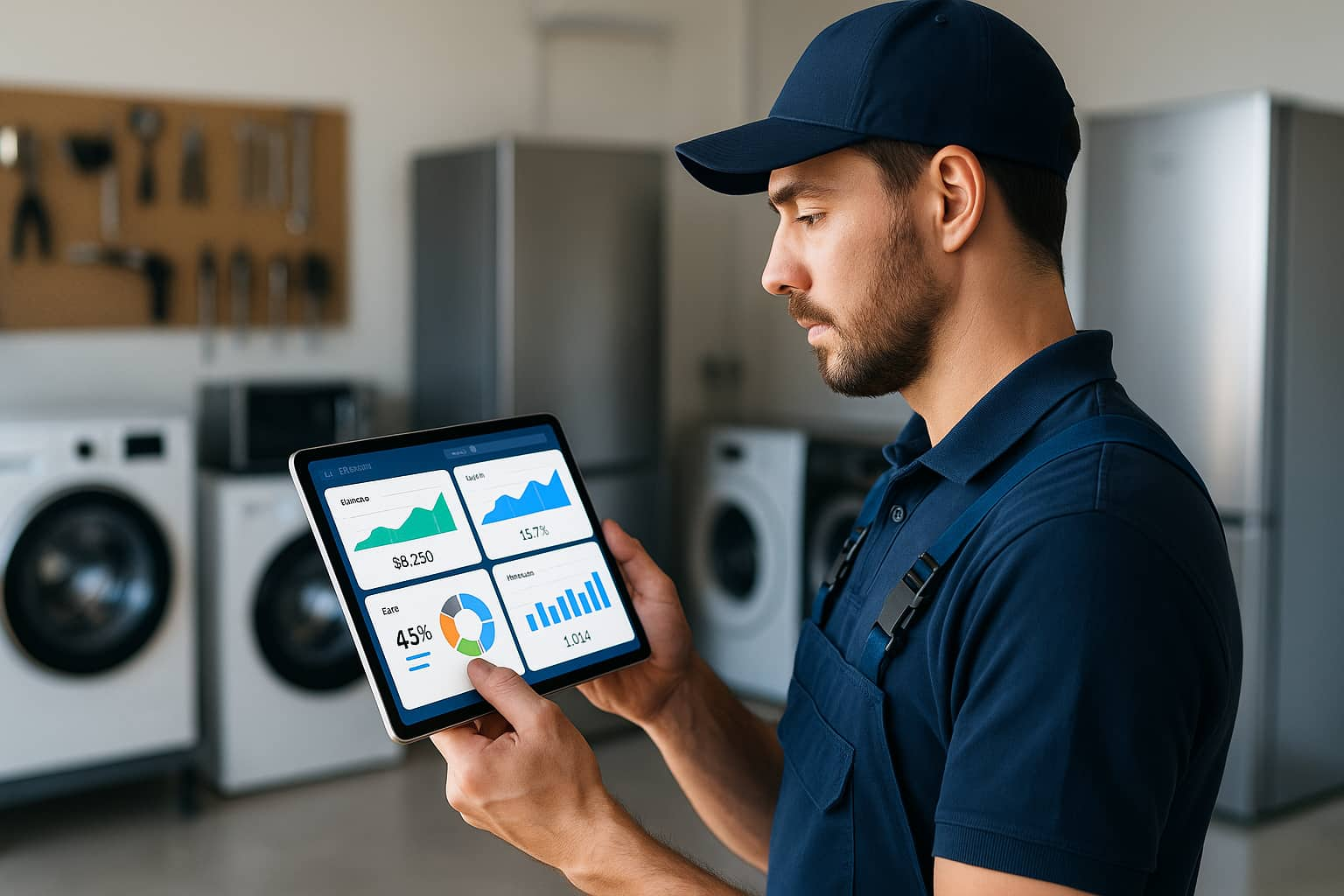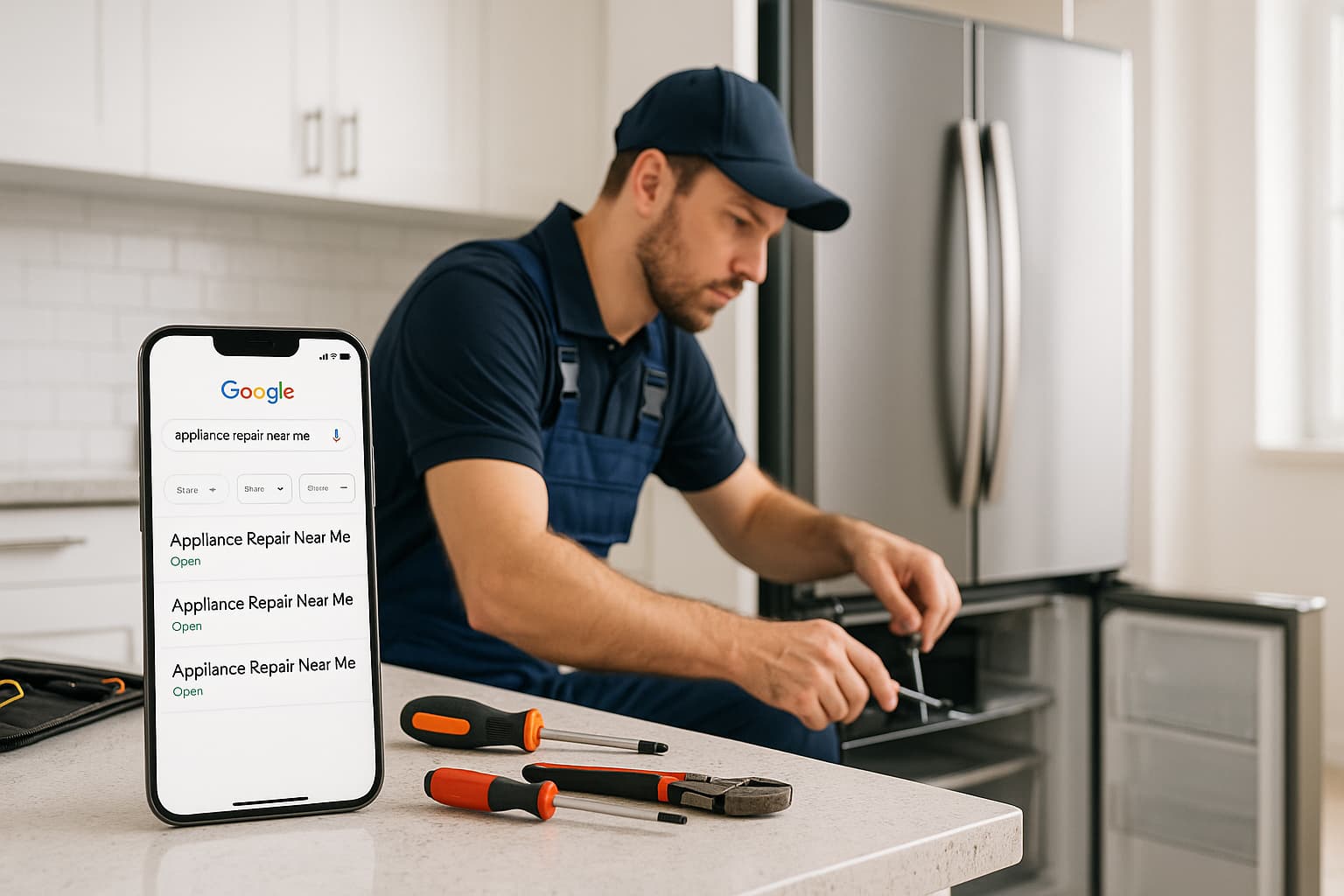3 Key Numbers Every Appliance Repair Business Must Track to Make More Money
Running an appliance repair business is tough. You fix broken washers and dryers all day, but your own profits might be broken too. Here's the thing - most repair shop owners focus on getting more customers but ignore the numbers that actually drive profits.
The truth is, small changes in the right areas can boost your income by thousands each month. You don't need fancy business degrees or expensive consultants. You just need to track three simple numbers.
This guide shows you exactly which numbers matter most. Plus, you'll learn how to use them to make more money from every job you do.
Table of Contents
Why These Numbers Matter for Your Appliance Repair Company
First-Time Fix Rate Makes or Breaks Profits
Average Revenue Per Call Boosts Income
Marketing ROI and Appliance Repair Lead Generation
Simple Tools to Track Your Numbers
Building a Numbers-Focused Team
Real Success Stories from Repair Shops
Your 30-Day Getting Started Plan
Why These Numbers Matter for Your Appliance Repair Company
Most appliance repair businesses run on thin profit margins. The average repair service makes about 32% gross profit. That means small problems can wipe out your earnings fast.
Many shop owners make decisions based on gut feelings. That worked years ago, but not anymore. Companies that track performance numbers see 22% higher productivity than those flying blind.
Want to know the secret? It's not about working harder. It's about working smarter by watching the right numbers.
Here's what happens when you don't track metrics:
You repeat callbacks without knowing why
Appliance repair ads and marketing dollars get wasted on strategies that don't work
Technicians miss easy upsell opportunities
Profits stay flat while expenses keep growing
The good news is fixing these problems is easier than you think.
First-Time Fix Rate Makes or Breaks Profits
Your first-time fix rate shows how often you solve problems on the first visit. This number directly impacts your bottom line more than any other metric.
Why This Number Matters Most
Nearly 30% of repair jobs need a second visit. Each callback costs you money through:
Extra travel time and gas
Unpaid labor hours
Lost opportunities for new appliance repair leads
Unhappy customers who leave bad reviews
Top repair shops fix 90-98% of jobs on the first visit. Struggling businesses often fall below 70%. The industry average sits around 75%.
How to Calculate Your Rate
The math is simple: First-Time Fix Rate = (Jobs fixed on first visit ÷ Total jobs) × 100
For example: 85 jobs fixed right the first time out of 100 total jobs = 85% fix rate.
Ways to Boost Your Fix Rate
Get Better Info Before You Go - Train your office staff to ask the right questions. Find out exactly what's wrong before sending a tech. This helps your team bring the right parts and tools.
Ask customers these key questions:
What exactly is the problem?
When did it start?
What's the make and model?
Did anyone try to fix it already?
Stock the Right Parts - Your techs can't fix what they don't have parts for. Look at your most common repairs and make sure truck inventory matches demand.
Track which parts get used most often. Keep those items stocked. Build relationships with suppliers who deliver same day for emergency needs.
Keep Training Your Team - Appliances change fast. Your techs need ongoing training to stay current. Schedule monthly training sessions on new models and common problems.
Create a high quality knowledge base your team can access from their phones. Include repair guides, part numbers, and troubleshooting steps.
Use Technology for Support - Give techs tablets with repair manuals and video tutorials. When they get stuck, they can get help without leaving the job site.
Include complete service history for returning customers. This helps techs understand what's been tried before.
Having detailed service history also helps reduce no-shows. Learn how to end no-shows and keep your appliance repair calendar full to protect the revenue metrics you're tracking.
Learn from Failed Fixes - When callbacks happen, find out why. Was it missing parts? Wrong diagnosis? Need more training? Use this info to prevent future callbacks.
Average Revenue Per Call Boosts Income
Every service call costs you money in travel time and vehicle expenses. The key is making more money from each visit to cover these fixed costs.
Why This Matters
It costs the same to drive to a $100 job as a $300 job. But the bigger job makes you more profit. Getting more value from existing customers costs less than finding new ones.
Repair shops that focus on better service offerings see upsell success rates over 30%.
How to Calculate It
Average Revenue Per Call = Total Revenue ÷ Number of Service Calls
Example: $50,000 monthly revenue from 200 calls = $250 average per call.
Track this number by service type, appliance category, and technician. This shows you where opportunities exist.
Ways to Increase Revenue Per Call
Price Your Services Right - Many repair shops charge too little. Research what competitors charge in your area. Consider premium pricing for emergency or weekend service.
Create service packages at different price points. Offer basic, standard, and premium options for common repairs.
Train Techs to Spot Opportunities - Your technicians see problems customers miss. Train them to identify worn parts that might fail soon. Teach them to explain maintenance benefits.
This isn't about being pushy. It's about being helpful by preventing future breakdowns.
Offer Maintenance Plans - Create annual service agreements for different appliance types. Bundle services like dryer vent cleaning with appliance checkups.
Maintenance plans create steady income and keep customers coming back. Maintenance plans are just one strategy for consistent revenue. Discover how to keep your appliance repair business fully booked year-round to maximize your average revenue per call and stabilize cash flow.
Expand What You Offer - Add related services like appliance installation if you only do repairs now. Consider small electrical work or HVAC maintenance.
Partner with appliance stores to provide extended warranty service.
Cross-Sell Smart - When fixing a dryer, mention dryer vent cleaning. During refrigerator repairs, suggest coil cleaning or water line replacement.
The key is offering services that make sense together.
Marketing ROI and Appliance Repair Lead Generation
Many repair shops waste money on appliance repair marketing that doesn't work. Without tracking, you can't tell which ads bring customers and which drain your budget.
Smart marketing strategies focus on channels that deliver measurable results.
Why You Need to Track This
Industry research shows repair companies often overspend on traditional ads while missing better digital opportunities. Tracking lets you move money to what actually works.
How to Calculate It
Customer Acquisition Cost = Marketing Expenses ÷ New Customers Gained
Marketing ROI = ((Revenue from Marketing - Marketing Cost) ÷ Marketing Cost) × 100
Calculate these numbers for each marketing channel - Google ads, social media, online directory listings, and referrals. Free appliance repair leads from referrals often have the highest conversion rates.
To improve your overall marketing ROI, explore 7 ways to get free appliance repair leads without paying for ads - these typically show the highest ROI since they cost nothing to acquire.
Ways to Improve Marketing Results
Use Call Tracking - Assign unique phone numbers to different ads. This shows exactly which marketing brings customers and what each customer costs.
Record calls to measure quality and track which ones become paying jobs.
Focus on Local Search - Most customers search for "appliance repair near me" on search engines. Make sure you show up in your service area:
Claim your Google Business Profile
Keep your business info consistent everywhere online
Get and respond to Google reviews
Create pages for each area you serve
Google searches drive most repair leads in today's market. To maximize your lead generation efforts, implement the 5 best ways to get appliance repair leads in 2025 and track their ROI using the methods outlined here.
Measure What Happens After Calls - Not every call becomes a paying customer. Track your conversion rates:
Calls to scheduled appointments
Appointments to completed jobs
Quotes to accepted work
Use this info to train your office staff to book more jobs.
Track Customer Lifetime Value - Some marketing brings customers who use you once. Others bring customers who call you for years.
Calculate the total value customers bring over time by marketing source. Spend more on channels that bring loyal customers.
One high-value channel to track is after-hours leads. Learn 7 ways to get appliance repair leads while you sleep and measure their ROI against your daytime marketing efforts.
Build a Referral System - Happy customers tell friends about good repair service. Create a formal referral program with tracking and rewards.
Track which customers give the most referrals and what makes them so happy. An effective appliance repair lead generation service often comes from satisfied customers.
Simple Tools to Track Your Numbers
Tracking metrics manually takes too much time and creates mistakes. Modern software makes it easy to collect and analyze data automatically.
Field Service Software
These platforms handle scheduling, dispatching, and reporting:
ServiceTitan: Full-featured but expensive
Housecall Pro: User-friendly for small teams
FieldEdge: Good QuickBooks integration
Service Fusion: Strong reporting features
Money and Accounting Tools
For financial tracking:
QuickBooks: Industry standard with job costing
Xero: Cloud-based with good reports
Mobile payment systems for faster cash flow
Marketing Tracking
To optimize your repair marketing performance:
CallRail: Tracks which ads generate calls
Google Analytics: Shows website visitor behavior
Google Ads: Built-in conversion tracking
All-in-One Dashboards
For complete performance monitoring:
Google Data Studio: Free dashboard creation
Tableau: Advanced analysis for bigger companies
Microsoft Power BI: Connects multiple data sources
Building a Numbers-Focused Team
Having tools isn't enough. Your team needs to care about metrics and use them to make better decisions.
Set Clear Goals
Establish specific targets:
First-time fix rate: Aim for at least 85%
Average revenue per call: Set quarterly improvement goals
Marketing ROI: Set minimum performance for each channel
Create Accountability
Metrics only work when tied to results:
Share performance data with your team
Hold regular review meetings
Reward improvement
Provide extra training where needed
Make Data Easy to See
Keep key numbers visible:
Create simple dashboards everyone can read
Send weekly reports to key people
Display performance indicators in the office
Give field staff mobile access to metrics
Use Data to Improve
Create a process for acting on insights:
Review metrics weekly for operations, monthly for strategy
Look for patterns and unusual results
Find root causes of problems
Make specific action plans
Put changes into place
Measure results and repeat
Real Success Stories from Repair Shops
Route Optimization Success
A mid-sized repair company added GPS routing and performance tracking. Results:
First-time fix rate jumped from 72% to 83%
Jobs per technician per day increased from 5.2 to 5.7
Fuel costs dropped 14%
Customer satisfaction improved 22%
The key was matching jobs to techs based on skills and cutting travel time between appointments.
Marketing Optimization Win
A small suburban repair shop implemented call tracking across all marketing. They discovered:
Newspaper ads used 40% of budget but brought only 12% of leads
Google Ads optimization cut cost per lead significantly
Monthly leads increased 34% while marketing spend dropped 15%
Success came from seeing which marketing actually delivered qualified customers.
Revenue Boost Results
A family repair business focused on increasing revenue per call. They achieved:
28% increase in average revenue per call (from $185 to $237)
Maintained high customer satisfaction
Created steady bonus income for technicians
They did this by analyzing common repairs, creating service tiers, training techs on consultative selling, and tracking performance by technician.
Your 30-Day Getting Started Plan
You don't need to change everything at once. Here's how to start tracking metrics in 30 days:
Days 1-7: Check Your Current Situation
Pick field service software if you don't have one
Start tracking the three key metrics
Gather 30 days of past data as your starting point
Write down your current processes
Days 8-14: Set Goals and Get Team Buy-In
Set specific targets for each metric
Create simple daily and weekly tracking
Hold team meeting to explain why metrics matter
Ask techs what stops them from fixing things right the first time
Days 15-21: Improve Your Processes
Start asking better questions before service calls
Review and improve parts inventory
Create standard procedures for common repairs
Set up call tracking for marketing
Days 22-30: Train and Review
Train techs on finding upsell opportunities
Practice common sales conversations
Look at your first three weeks of data
Make changes based on what you learned
Schedule regular weekly and monthly reviews
The Bottom Line
Tracking the right numbers isn't optional anymore. It's how successful repair shops stay profitable while others struggle.
Focus on these three metrics: first-time fix rate, average revenue per call, and marketing ROI. These numbers give you the power to make smart decisions that directly boost your profits.
The best repair businesses combine great technical skills with smart business decisions. They know every prevented callback, optimized service call, and properly spent marketing dollar adds to their bottom line.
Start with the basics in this guide. Add more tracking as you get comfortable with the data. The insights you gain will show you exactly how to build a more profitable repair business.
Ready to transform your appliance repair business with smart tracking? Get exclusive appliance repair leads today by signing up for free with ResultCalls!

Alex Gambashidze
Marketing Associate at ResultCallsHello everyone! My name is Alex and I write these blogs to help educate small business owners on different ways to grow their business. My goal is to make lead generation as easy as possible for you. After reading these blogs, I hope you leave with some actionable steps that will get you closer to growing your business :)
2,000+
Happy local businesses
See what some of them have to say.


